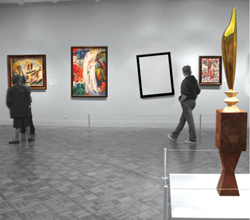Art of the Sale

Photo by Kristine Strom
When members of the board of trustees of Randolph College needed to shore up the school’s endowment last fall, they turned to the school’s Maier Museum of Art.
The on-campus museum at the Lynchburg, Va., school is renowned for its collection of 19th and 20th century American art that includes works by George Bellows, Edward Hicks and Ernest Martin Hennings. But the school’s trustees saw the collection as simply too precious to keep.
As at a growing number of colleges and universities, Randolph’s trustees decided to capitalize on soaring art prices by selling several pieces from the Maier collection, including Bellows’ Men of the Docks and Hennings’ Through the Arroyo. By some estimates the sale could have brought the school as much as $50 million.
Instead, the school—until last year known as Randolph-Macon Woman’s College—was hit with a lawsuit claiming the sale violated the wishes of the donors of the art, as well as the school’s charitable trust with the community.
“The question one has to ask is when is it appropriate to sell art to fund nonart endeavors,” says Philadelphia lawyer Sharon Erwin. While the trustees of the university also have a fiduciary obligation to their organization, “at what point do they say it’s in the best interest of the institution to sell this art asset for nonart purposes?”
So far that question does not appear to be answered. But the issue has raised the ire of art lovers and university administrators nationwide.
Take the case of Fisk University. In 2005, the Nashville, Tenn., school announced plans to sell two pieces from its famed Alfred Stieglitz Collection to help the school’s dire finances. Each of the works was valued at $8.5 million, according to documents associated with a lawsuit over the sale.
The works of art, 101 of them, had been donated by Stieglitz’s widow, artist Georgia O’Keeffe, whose estate intervened, claiming the donation was made with the intent that the entire collection stay intact.
Though Fisk planned to settle the suit with the O’Keeffe Foundation, the parties eventually agreed to an art-sharing arrangement worth $30 million with the Crystal Bridges Museum of American Art in Bentonville, Ark., which is slated to open in 2010.
Given the outcry over the sale of precious art gifts, some schools are beginning to see the value of negotiating with the community—as long as they still get their price.
In 2006, Thomas Jefferson University in Philadelphia sparked controversy when trustees decided to sell for $68 million the famed Thomas Eakins painting The Gross Clinic to the National Gallery of Art and the Crystal Bridges Museum. The medical school had purchased the piece for $200 after the 1876 Centennial Exhibition; it said it needed the proceeds for capital projects that would help further its educational mission.
The proposed sale provoked such a huge local outcry that the school’s trustees decided to allow community institutions a chance to match the $68 million offer. Philadelphia civic leaders eventually raised the money, but the incident left open questions raised about the relationship of a community to its art.
“Some people believe that there is an obligation to the community,” says Patty Gerstenblith, a cultural heritage law professor at DePaul University. “But it’s a little bit difficult to find a legal source for that obligation unless we go back to the donor’s intent.
“Did the donor intend to benefit a particular community?” she asks. “If so, then perhaps there is an obligation to keep the work of art within the community—though not necessarily at that particular institution but maybe to sell it within the community.”
Perhaps the real lesson for these institutions of higher learning is to be wary of donors bearing art.
Schools “need to be careful about what gifts they accept in the first place and what restrictions they are willing to accept when they take a donation because those are exactly the kind of things that lead to trouble,” Gerstenblith says.



